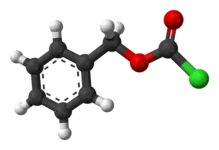Benzyl chloroformate
Benzyl chloroformate is the benzyl ester of chloroformic acid. Also known as benzyl chlorocarbonate it is an oily colorless liquid although impure samples appear yellow. It is also known for its pungent odor. In contact with water it degrades.
 | |
 | |
| Names | |
|---|---|
| Preferred IUPAC name
Benzyl carbonochloridate | |
| Other names
Benzyl chloroformate Benzyloxycarbonyl chloride Z-Chloride | |
| Identifiers | |
3D model (JSmol) |
|
| ChemSpider | |
| ECHA InfoCard | 100.007.205 |
| EC Number |
|
PubChem CID |
|
| RTECS number |
|
| UNII | |
| UN number | 1739 |
CompTox Dashboard (EPA) |
|
| |
| |
| Properties | |
| C8H7ClO2 | |
| Molar mass | 170.59 g·mol−1 |
| Density | 1.195 g/cm3 |
| Boiling point | 103 °C (217 °F; 376 K) (20 Torr) |
| Hazards | |
| Safety data sheet | External MSDS |
| GHS pictograms |   |
| GHS Signal word | Danger |
| H314, H400, H410 | |
| P260, P264, P273, P280, P301+330+331, P303+361+353, P304+340, P305+351+338, P310, P321, P363, P391, P405, P501 | |
| Flash point | 80 °C (176 °F; 353 K) |
Except where otherwise noted, data are given for materials in their standard state (at 25 °C [77 °F], 100 kPa). | |
| Infobox references | |
Preparation
It is prepared in the lab by treating benzyl alcohol with phosgene. Phosgene is used in excess to minimise the production of the carbonate.[1]
Amine protection
The “carboxybenzyl group” (Cbz, benzyloxycarbonyl) is commonly used in organic synthesis for the introduction of the carboxybenzyl (abbreviated Cbz or Z) protecting group for amines. It is a key protecting group for amines, suppressing its nucleophilic and basic properties.
Alternatively, as in the Curtius rearrangement, carboxybenzyl can be generated by the reaction of an isocyanate with benzyl alcohol.
Common amine protection procedures include:
- Benzyl chloroformate and a base, such as sodium carbonate in water at 0 °C[2]
- Benzyl chloroformate and magnesium oxide in ethyl acetate at 70 °C to reflux[3]
- Benzyl chloroformate, DIPEA, acetonitrile and scandium trifluoromethanesulfonate (Sc(OTf)3)[4]
The method was first used by Max Bergmann and Leonidas Zervas in 1932 for the synthesis of peptides.[2] The abbreviation Z is in honor of Zervas.
Deprotection
Hydrogenolysis in the presence of a variety of palladium-based catalysts is the usual method for deprotection. Palladium on charcoal is typical.[5]
Alternatively, strong Lewis acids have been used, provided that a trap is provided for the released benzyl carbocation.[6] The protected amine can be deprotected by catalytic hydrogenation or treatment with HBr, yielding a terminal carbamic acid that then readily decarboxylates to yield the free amine. Typically hydrogen gas and activated palladium on carbon are used.[7]
References
- Hough, L.; Priddle, J. E. (1961). "Carbonate derivatives of methyl α-D-mannopyranoside and of D-mannose". J. Chem. Soc. 1961: 3178–3181. doi:10.1039/JR9610003178.
- Bergmann, Max; Zervas, Leonidas (1932). "Über ein allgemeines Verfahren der Peptid-Synthese" [On a general method of peptide synthesis]. Berichte der deutschen chemischen Gesellschaft. 65 (7): 1192–1201. doi:10.1002/cber.19320650722.
- Dymicky, M. (1989-02-01). "Preparation of Carbobenzoxy-L-Tyrosine Methyl and Ethyl Esters and of the Corresponding Carbobenzoxy Hydrazides". Organic Preparations and Procedures International. 21 (1): 83–90. doi:10.1080/00304948909356350. ISSN 0030-4948.
- Aggarwal, Varinder K.; Humphries, Paul S.; Fenwick, Ashley (1999). "A Formal Asymmetric Synthesis of Anatoxin-a Using an Enantioselective Deprotonation Strategy on an Eight-Membered Ring". Angewandte Chemie International Edition. 38 (13–14): 1985–1986. doi:10.1002/(SICI)1521-3773(19990712)38:13/14<1985::AID-ANIE1985>3.0.CO;2-7.
- Felpin, François-Xavier; Fouquet, Eric (2010-11-02). "A Useful, Reliable and Safer Protocol for Hydrogenation and the Hydrogenolysis of O-Benzyl Groups: The In Situ Preparation of an Active Pd0/C Catalyst with Well-Defined Properties". Chemistry – A European Journal. 16 (41): 12440–12445. doi:10.1002/chem.201001377. ISSN 1521-3765. PMID 20845414.
- Theodora W. Greene, Peter G. M. Wuts (1999). Protecting Groups in Organic Synthesis (3 ed.). J. Wiley. ISBN 978-0-471-16019-9.CS1 maint: uses authors parameter (link)
- Jakubke, Hans-Dieter; Sewald, Norbert (2008). Peptides from A to Z: A Concise Encyclopedia. John Wiley & Sons. ISBN 978-3-527-62117-0.



